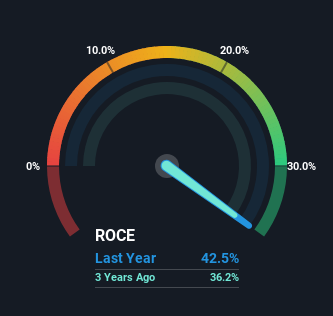- United States
- /
- Professional Services
- /
- NasdaqGS:PAYX
Capital Investment Trends At Paychex (NASDAQ:PAYX) Look Strong
If you're looking for a multi-bagger, there's a few things to keep an eye out for. One common approach is to try and find a company with returns on capital employed (ROCE) that are increasing, in conjunction with a growing amount of capital employed. This shows us that it's a compounding machine, able to continually reinvest its earnings back into the business and generate higher returns. So, when we ran our eye over Paychex's (NASDAQ:PAYX) trend of ROCE, we really liked what we saw.
What Is Return On Capital Employed (ROCE)?
Just to clarify if you're unsure, ROCE is a metric for evaluating how much pre-tax income (in percentage terms) a company earns on the capital invested in its business. To calculate this metric for Paychex, this is the formula:
Return on Capital Employed = Earnings Before Interest and Tax (EBIT) ÷ (Total Assets - Current Liabilities)
0.42 = US$2.2b ÷ (US$10b - US$5.3b) (Based on the trailing twelve months to August 2024).
Thus, Paychex has an ROCE of 42%. In absolute terms that's a great return and it's even better than the Professional Services industry average of 14%.
Check out our latest analysis for Paychex

Above you can see how the current ROCE for Paychex compares to its prior returns on capital, but there's only so much you can tell from the past. If you're interested, you can view the analysts predictions in our free analyst report for Paychex .
The Trend Of ROCE
In terms of Paychex's history of ROCE, it's quite impressive. Over the past five years, ROCE has remained relatively flat at around 42% and the business has deployed 35% more capital into its operations. Now considering ROCE is an attractive 42%, this combination is actually pretty appealing because it means the business can consistently put money to work and generate these high returns. If these trends can continue, it wouldn't surprise us if the company became a multi-bagger.
Another thing to note, Paychex has a high ratio of current liabilities to total assets of 51%. This can bring about some risks because the company is basically operating with a rather large reliance on its suppliers or other sorts of short-term creditors. Ideally we'd like to see this reduce as that would mean fewer obligations bearing risks.
The Key Takeaway
In summary, we're delighted to see that Paychex has been compounding returns by reinvesting at consistently high rates of return, as these are common traits of a multi-bagger. Therefore it's no surprise that shareholders have earned a respectable 89% return if they held over the last five years. So while the positive underlying trends may be accounted for by investors, we still think this stock is worth looking into further.
Paychex does have some risks though, and we've spotted 1 warning sign for Paychex that you might be interested in.
High returns are a key ingredient to strong performance, so check out our free list ofstocks earning high returns on equity with solid balance sheets.
New: Manage All Your Stock Portfolios in One Place
We've created the ultimate portfolio companion for stock investors, and it's free.
• Connect an unlimited number of Portfolios and see your total in one currency
• Be alerted to new Warning Signs or Risks via email or mobile
• Track the Fair Value of your stocks
Have feedback on this article? Concerned about the content? Get in touch with us directly. Alternatively, email editorial-team (at) simplywallst.com.
This article by Simply Wall St is general in nature. We provide commentary based on historical data and analyst forecasts only using an unbiased methodology and our articles are not intended to be financial advice. It does not constitute a recommendation to buy or sell any stock, and does not take account of your objectives, or your financial situation. We aim to bring you long-term focused analysis driven by fundamental data. Note that our analysis may not factor in the latest price-sensitive company announcements or qualitative material. Simply Wall St has no position in any stocks mentioned.
About NasdaqGS:PAYX
Paychex
Provides human capital management solutions (HCM) for payroll, employee benefits, human resources (HR), and insurance services for small to medium-sized businesses in the United States, Europe, and India.
Adequate balance sheet average dividend payer.
Similar Companies
Market Insights
Community Narratives



